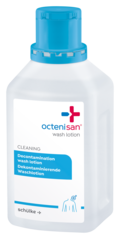
Preoperative washing before elective procedures
Postoperative wound infections are a common complication of surgical procedures. They not only lead to increased mortality and longer hospital stays, but also generate enormous costs for the healthcare system.
According to estimates, postoperative wound infections cost the German healthcare system up to 3 billion euros every year1.
Postoperative wound infections have therefore increasingly become the focus of public attention. The keyword "patient safety" is particularly
in focus when it comes to postoperative wound infections in orthopaedics.
Due to the increasing number of people worldwide with hip and knee endoprostheses, the implantation of artificial joints is already considered a routine procedure. Although the SSI rates following this type of procedure are comparatively low, the increasing frequency also increases the economic and health implications.
The postoperative wound infection rate is 0.5% for knee endoprostheses and between 1% and 3% for hip endoprostheses.2,3 Postoperative wound infections are the most common indication for revision surgery in knee endoprosthetics and are the third most common indication for hip endoprosthetics. For example, the length of hospital stay can double or even triple after a hip endoprosthesis. A length of stay of up to 28 days therefore results in significantly higher costs.
Patients with postoperative wound infections after knee endoprostheses also have a significantly longer hospital stay than patients without infection (up to 24 days). The average cost of treatment for patients with infection is $116,000 (€100,000) compared to $28,000 (€24,600) for patients without infection.4
If left untreated, wound infections can penetrate deep into the joint and develop into a serious and costly periprosthetic infection.
Preoperative patient decontamination prior to knee surgery could save between $0.8 and $2.3 billion5 annually in the US. Early preventive measures are therefore strongly recommended6.
[1] BVMed, Hintergrundinformationen Postoperative Wundinfektionen,
http://www.krankenhausinfektionen.info/ki-de/kikrankenhaus-infektionen/post-operative-wundinfektionen
[2] Mistry J.B. et al., 2017: Decreasing the Incidence of Surgical-Site Infections after Total Joint Arthroplasty.
[3] Nationales Referenzzentrum für Surveillance von nosokomialen Infektionen (NRZ), 2017: Modul OP-KISS. Reference data. Calculation period: January 2012 to December 2016.
[4] Kapadia B.H. et al., 2014: The economic impact of periprosthetic infections following total knee arthroplasty at a specialized tertiary-care center.
[5] Kapadia B.H. et al, 2013: Economic evaluation of chlorhexidine cloths on healthcare costs due to surgical site infections following total knee arthroplasty.
[6] Kurtz S.M. et al., 2012: Economic burden of periprosthetic joint infection in the United States.
Our products

octenisan® md nasal gel
intended to be used for moistening and decontamination by physical cleansing of the nasal vestibules as well as for supportive ...
octenisan® Set
octenisan® wash lotion and octenisan® md nasal gel for preoperative decontamination of skin, hair and nasal vestubles

Data protection notice
We use analysis methods (e.g. cookies) to measure how often our website is visited and how it is used. We also use cookies to link your page visits and website usage with your customer data stored in our CRM system in order to be able to address you individually, i.e. based on your interests and usage. We alsowe embed third-party content from other providers (e.g. videos). We have no influence on further data processing and any tracking by the third-party provider.In this context, we also use service providers in third countries outside the EU that may not guarantee an adequate level of data protection, which entails the following risks Access by authorities without informing the data subject, no data subject rights, no legal remedies, loss of control.By hiring us, you consent to the processes described above. You can revoke your consent with effect for the future. You can find more information in our privacy policy





















